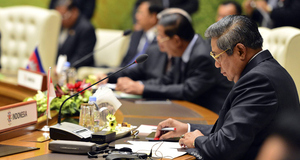Opinion:Japan's Multilateral Gambit: Leading the Charge Toward an East Asian Community
By
2010, Vol. 2 No. 06 | pg. 1/1
IN THIS ARTICLE
KEYWORDS
If Japan was a person, it would be an exceptionally wealthy yet rapidly aging individual, who, for two decades, had been struck by illness. One might therefore find it unexpected for this person to be busily working on constructing the new face of Asian regional economic cooperation. This, nevertheless, is exactly what Japan is doing. Since the Democratic Party of Japan crushed the dominant Liberal Democratic Party in the August 2009 elections, the new Japanese administration, led by Prime Minister Yukio Hatoyama, has been articulating its vision for a new, integrative regional economic body in Asia, the East Asian Community (EAC). Hats off to HatoyamaThe idea of an EAC is not new. However, ever since Hatoyama floated his conception of an EAC in September 2009, the idea has gathered momentum. The Japanese Foreign Minister, Katsuya Okada, has stated the EAC is the Hatoyama administration’s top foreign policy priority. This is not empty rhetoric. In March this year, Japan hosted summits, symposiums and seminars on the EAC. These were not affairs for stuffy academics; rather, they were high-profile events featuring diplomatic representatives from neighbouring countries. One event was televised in Japan. For Japan, a country which has exceptionally strong security ties with the United States, the notion of plunging itself into Asian economic regionalism may seem counter-intuitive. However, it makes perfect sense. At present, East Asia accounts for roughly 25 per cent of the world’s Gross Domestic Product (GDP). This figure is set to reach 40 per cent by 2030. There is little wonder then, that Hatoyama has been declaring Japan’s ‘proper place of being’ in Asian economic markets. The ‘Sick Man’ of AsiaHatoyama’s keenness to promote Japan in an economically vibrant region also stems from a need to put the brakes on Japan’s relative decline. Following the collapse of its property market in the 1990s, Japan has failed to regain its economic mojo, despite PM Junichiro Koizumi’s attempt at reform. Japanologists no longer speak of a lost decade of economic growth, but of lost decades. An aging and shrinking population compounds these woes. By 2015, a quarter of Japanese citizens will be older than 65, compared with 12 per cent in 1990. The number of children per woman in Japan is 1.3, whereas the replacement rate is 2.1. The picture may be bleak, but Japan will still remain one of the four largest economies in the world by 2040. If Hatoyama can succeed in creating an EAC, the Japanese economy may receive a desperately needed jump-start. Moreover, if Japan is the architect of this new economic initiative, it may allow Hatoyama to reverse his country’s ailing international status.Alphabet SoupIf anything has typified the post-Cold War international order, it is the proliferation in regional forums and multilateral bodies. Asia alone, relatively new to multilateral diplomacy, has a veritable alphabet soup of associations. The Asia-Pacific Economic Cooperation (APEC) vies with the Association of South-East Asian Nations (ASEAN) for dominion as the premier regional body. ASEAN with its numerous configurations, such as ASEAN + 3 and ASEAN + 6, has given birth to the ASEAN Regional Forum (ARF). The East Asia Summit (EAS) is an annual regional forum, dealing with a multiplicity of issues. China has initiated the Shanghai Cooperation Organisation (SCO) with its nearest neighbours. Confusion abounds. It is hoped that the EAC will transverse the multitude of bodies and will express a collective position on economic issues. The purpose of the EAC would not, therefore, be to add to the alphabet soup, but to work within it. One Voice for AsiaWhat is “Asia”? Where does “Asia” start and where does “Asia” end? These questions are neither tricks nor philosophical curiosities, but practical considerations Hatoyama and his team must contemplate. The distinction is entirely subjective. For instance, in On Dit 78:1, Primer described Afghanistan as being in ‘South Asia’. In the subsequent issue, a correction listed Afghanistan as in the ‘Middle East’. Both labels are perfectly acceptable, but use of them underlies respective notions of Asia. The decision as to which countries are included and which will be omitted has the potential to make or break Hatoyama’s vision. The Japanese Ministry of Foreign Affairs advanced that the EAC should encompass the ASEAN + 6 group. This would potentially include: Indonesia, Malaysia, the Philippines, Singapore, Thailand, Brunei, Vietnam, Laos, Myanmar, Cambodia, China, Japan, South Korea, India, Australia and New Zealand. The term “East Asian Community” is thus a misnomer. The proposed EAC includes countries from all across the Asian region and would transverse languages, political systems, religious beliefs, ethnicity, levels of economic development and cultural custom. Presenting a solitary voice on economics may prove contentious. Yet, other pan-Asian institutions have successfully contributed to regional economic cooperation and security. There is no reason why the EAC would not. Feasible, or Folly?Hatoyama’s proposal, if it is accepted, could be the genesis of a regional trading bloc which would surpass the economic clout of the European Union. The European Union, however, did not appear overnight. Neither will an EAC. Similar ideas have been proposed time and time again, even from our own Prime Minister, only to disappear into obscurity. Despite the unusual source of the proposal, there is hope for an EAC. Given the vibrant economic growth in the region, a regional trading bloc will eventually occur. Time will tell whether Hatoyama’s proposal will gain enough support to spur the leaders of the nominated countries into action. One thing is for sure though: Japan, at long last, has a spring in its step. Suggested Reading from Inquiries Journal
Inquiries Journal provides undergraduate and graduate students around the world a platform for the wide dissemination of academic work over a range of core disciplines. Representing the work of students from hundreds of institutions around the globe, Inquiries Journal's large database of academic articles is completely free. Learn more | Blog | Submit Latest in Opinion |


















